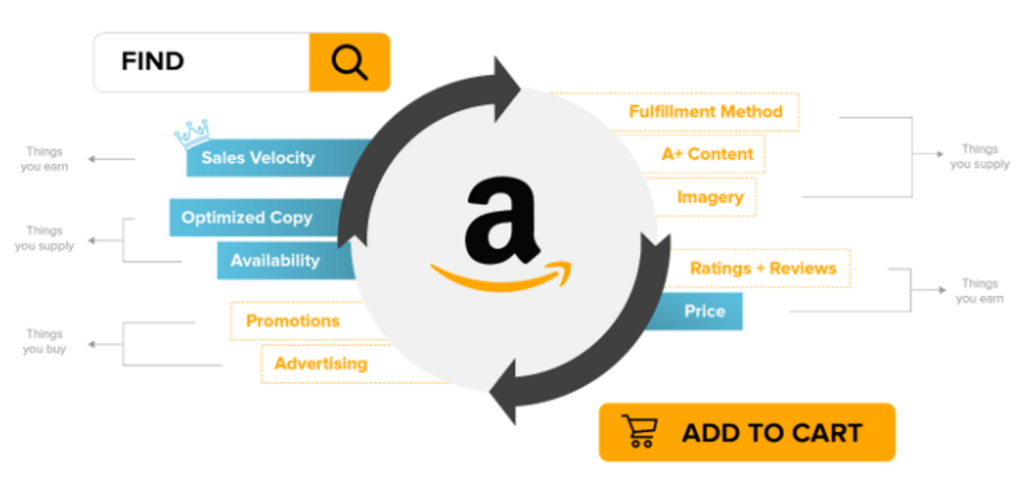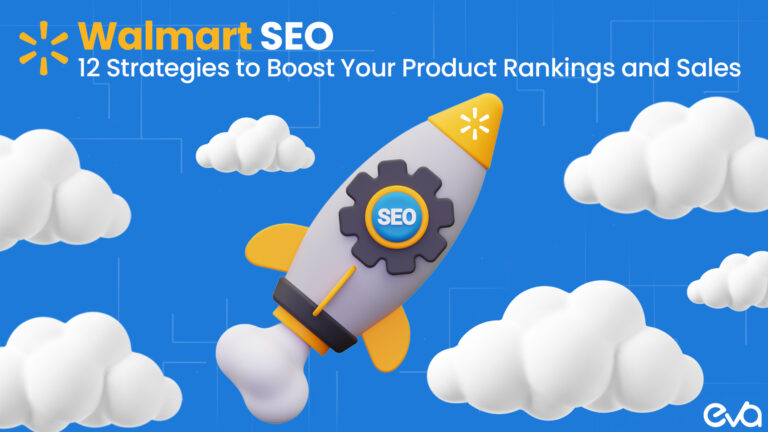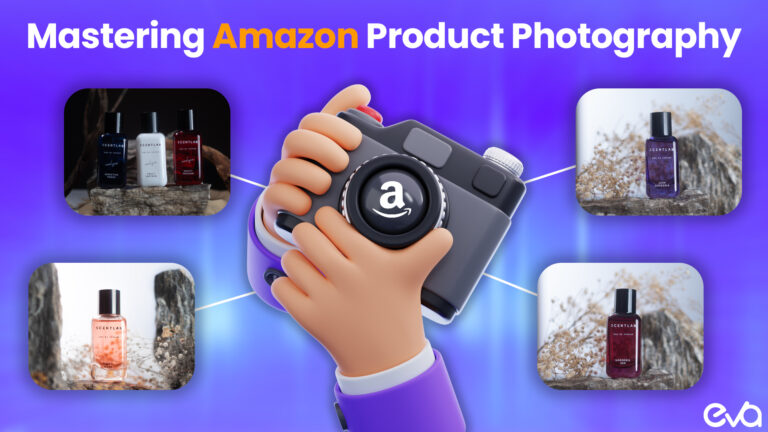Navigating the world of Amazon selling can be challenging, especially with the ever-evolving algorithms that dictate product search rankings.
Understanding the Amazon A10 algorithm is crucial to achieving top rankings, driving sales, and staying competitive on the platform.
In this blog post, we will demystify the Amazon A10 algorithm and provide you with actionable tips to help you optimize your listings and boost your search rankings.
Let’s dive in and unravel the secrets behind the Amazon A10 algorithm!
Table of Contents
What Is The Amazon A10 Algorithm?
The Amazon A9 and A10 algorithms are the search engines that power Amazon’s product rankings. The A10 algorithm is an updated version of A9, with an enhanced focus on factors like conversion rate, customer satisfaction, and seller authority.
By understanding the factors influencing the A10 algorithm, sellers can optimize their listings and improve their visibility on Amazon.
The A10 Algorithm is constantly being updated, and Amazon does not release details about how it works.
However, there is some speculation that the Algorithm prefers products with high customer satisfaction and positive reviews.
Additionally, it is thought that the Algorithm favors products priced competitively and with Amazon’s Choice designation.
While the specifics of the Amazon A10 algorithm remain a mystery, understanding how it works can help optimize your product listings for better visibility in search results.
Read More: Amazon Search Suggestion Expander
How Does The Amazon A10 Algorithm Work?
No evidence can clearly determine how an online shopper searches for a product. There is also no way to pinpoint precisely how Amazon’s Algorithm targets customer queries.
As a result, everything from keyword relevance and sales velocity to product availability and fulfillment methods can make or break your ascension to the top of Amazon search results.
What happens is that the search algorithm evolves and changes all the time. To adapt to the ever-evolving market trends, an Amazon seller should understand the main ranking factors used as input into the A10 Algorithm.
What Are The Ranking Factors For Amazon A10 Algorithm?
Several factors contribute to your product’s ranking in Amazon’s search results. We’ll dive into these factors to help you understand how to optimize your listings for the A10 algorithm.
Keyword Relevance
Keyword relevance refers to how closely your product titles, descriptions, and backend keywords match popular customer search terms.
To improve your keyword relevance, research popular keywords in your niche and incorporate them into your product listings naturally and accurately.
Use keywords in your bullet points and product description sections to help customers and the Amazon A9 algorithm quickly understand everything about your product.
But how often should you work on product keyword relevance? Regularly monitor keyword trends and update your listings to stay relevant and competitive.
Impressions
Impressions refer to the number of times your product appears in search results. Sellers can influence their images through keyword optimization and other listing improvements.
What can you do to improve how often products appear in top searches? Work on your keyword relevance, monitor your click-through rate, and ensure your listings are well-optimized for customer engagement.
The Amazon A9 / A10 Algorithm weights all these factors to determine whether your listings are relevant to market searchers.
Click-Through Rate (CTR)
CTR is the percentage of users who click on your product listing after seeing it in search results. Factors such as unattractive images, poor titles, and uncompetitive pricing can deter customers from clicking on your listing.
What actionable steps can sellers take to have more customers click on product listings? Improve your product images, craft compelling titles, and ensure competitive pricing to increase your CTR.
Here’s a quick tip to make simple CTR improvements with significant results. Your product’s title, main image, and price are the first things customers notice, so improve these to earn more clicks on your listing pages.
Conversion Rate
Conversion rate is the percentage of users who purchase after clicking on your product listing. A low conversion rate may result from poor product descriptions, good customer reviews, or uncompetitive pricing.
Which optimizations can you complete to improve your conversion rate? Enhance product descriptions, encourage positive customer reviews, and ensure your pricing is competitive to boost your conversion rate.
Amazon PPC Advertising
Pay-Per-Click (PPC) advertising can increase visibility, drive sales, and improve product rankings. Although PPC isn’t as significant of a ranking factor in the A10 algorithm, it still impacts CTR, conversions, and sales velocity, which are all important.
What should you focus on while building PPC campaigns to improve your listing rankings? Optimize your keywords, set competitive bids, and monitor campaign performance to maximize the effectiveness of your PPC campaigns.
Sales History
Amazon sales history refers to a seller’s past performance, including sales volume, refund rates, shipping speed, and defective product rates.
Amazon uses sales history to gauge a seller’s reliability and customer satisfaction, influencing search rankings.
A high refund rate, slow shipping speed, or significant defective product rate can harm your sales history, leading to lower search rankings.
Your brand can improve sales history over time. To enhance your sales history, provide excellent customer service, prompt shipping, and quality products.
Factors That Influence Amazon Sales History
Sales history is a long-term metric requiring consistent efforts and attention to detail. Here are some strategies to help you improve your sales history on Amazon:
Enhance Customer Service
Respond promptly and professionally to customer inquiries and concerns. Train your customer service team to handle issues efficiently and effectively, ensuring customer satisfaction.
Efficient Order Fulfillment
Streamline your order processing and shipping operations to minimize delays and errors. Consider using Amazon FBA (Fulfillment by Amazon) to take advantage of Amazon’s fulfillment network and offer Prime shipping to your customers.
Improve Product Quality
Regularly evaluate your products and suppliers to ensure high-quality products meet customer expectations. Implement strict quality control measures to minimize the chances of selling defective products.
Monitor Customer Feedback
Pay close attention to customer reviews and feedback. Use this information to identify areas for improvement and take corrective action when necessary.
Manage Returns and Refunds
Develop a transparent and fair return policy that makes it easy for customers to return defective or unsatisfactory products. Process refunds promptly to maintain customer trust and satisfaction.
Focus on Building a Positive Reputation
Encourage satisfied customers to leave positive reviews and ratings, which can counteract negative feedback and help improve your overall sales history.
By consistently working on these strategies, you can gradually improve your sales history, leading to better search rankings and increased visibility on Amazon.
Remember that it takes time and effort, so be prepared to invest resources into this aspect of your business.
Sales Velocity
Sales velocity is the rate at which you sell Amazon products over a specific time. Everything from price to product demand, seasonality, and listing quality all influence sales velocity.
Why It Matters & How To Improve Sales Velocity

A higher sales velocity indicates a strong demand for your products and can contribute to better search rankings on Amazon. Here are some strategies to help you increase your sales velocity:
Optimize Your Listings
Ensure your product titles, descriptions, images, and keywords are well-optimized to attract customers and provide them with the information they need to purchase. Regularly update your listings to maintain relevance and competitiveness.
Adjust Pricing
Keep an eye on your competitors’ prices and market trends to ensure your pricing remains competitive. Experiment with pricing strategies, such as offering discounts or bundling products, to find the optimal price point that maximizes sales.
Run Promotions
Utilize Amazon promotions, such as Lightning Deals and Coupons, to create a sense of urgency and attract more customers. Also, track which advertisements work best for your products and implement them strategically to increase sales.
Use PPC Campaigns
Invest in Amazon PPC (Pay-Per-Click) advertising to increase your products’ visibility and drive more traffic to your listings. Optimize your campaigns by focusing on relevant keywords, setting competitive bids, and monitoring performance regularly.
Monitor and Adapt to Seasonal Trends
Be aware of seasonal trends and demand fluctuations in your niche. Adjust your inventory levels, pricing, and marketing efforts to capitalize on peak seasons and minimize the impact of slow periods.
Improve Customer Reviews
Encourage satisfied customers to leave positive reviews and ratings for your products. High ratings and positive reviews can instill trust in potential customers, increasing sales.
Engage in Off-Amazon Marketing
Drive traffic to your Amazon listings from external sources, such as social media, email marketing, or your website, to increase overall sales and improve sales velocity.
By implementing these strategies, you can effectively increase your sales velocity and improve your search rankings on Amazon.
Remember that sales velocity is an ongoing metric that requires continuous monitoring and optimization to maintain and enhance your performance on the platform.
Organic Sales
Organic sales refer to purchases made by customers who find your product through natural search results rather than paid advertising.
High organic sales mean your product is relevant to and appealing to customers, positively impacting your search rankings.
How can sellers achieve more organic sales? Improve your keyword relevance, listing quality, and customer reviews to boost organic sales.
When your Amazon SEO efforts come together, you’ll notice much higher search placement and, in turn, an increase in organic sales.
Internal Sales
Internal sales include purchases made through upselling, cross-selling, brand store sales, and off-site sales. These sales can enhance your overall performance and search rankings on Amazon.
Here are the different internal sales methods to focus on:
Use Frequently Bought Together & Other Cross-Selling Strategies
If Amazon suggests products to customers, you’ll earn better search placement results if they buy them. Product relevance, customer behavior, and sales history can influence your products’ appearance in upselling and cross-selling suggestions.
Bundle complementary products, offer promotions, and ensure your listings are well-optimized and attractive. These steps will improve how often you upsell and cross-sell items to existing and prospective customers.
Improve Brand Store Sales
A brand store is a customized, branded landing page on Amazon that showcases your products and brand story.
Building a brand store can enhance your brand image, provide a cohesive shopping experience, and drive additional sales if you’re a registered brand on Amazon.
Only sellers enrolled in Amazon’s Brand Registry program can create brand stores. After building your store, regularly update your page to keep it fresh, relevant, and engaging for customers.
Drive Off-Site Sales
Off-site sales are purchases made by customers who arrive at your Amazon listing through external traffic sources, such as social media, email marketing, or your website.
Utilize social media marketing, email campaigns, and SEO optimization on your website to drive external traffic to your Amazon listings.
Track off-site sales using Amazon Attribution, a tracking and analytics tool, to monitor the performance of your off-site marketing efforts and measure their impact on your Amazon sales.
Customer Reviews
Amazon is famous for being customer-obsessed. It ensures customer satisfaction by ranking the popular products on top of the search results.
That’s why a product with more positive Amazon reviews (generally with the most reviews) will sit at the top of search results pages.
Not to mention, customer reviews are also one of the customers’ most important decision-making factors.
Price
Most Amazon shoppers are budget-conscious, and Amazon is obsessed with the customers. That’s why the products with more competitive prices have a better chance of ranking #1 on the search results page and winning the Amazon buy box.
How To Improve Your Prices For Better A10 Algorithm Rankings
To ensure your products have competitive pricing and better ranking potential, consider the following strategies:
Conduct Regular Price Analysis
Monitor your competitors’ prices and industry trends to identify the optimal price range for your products. This will help you stay competitive and maintain profitability while attracting price-sensitive customers.
Utilize Price Tracking Tools
Use Amazon repricing tools or other price-tracking software to keep track of price fluctuations and adjust your prices automatically or manually as needed. This can help you maintain a competitive edge while saving time on manual price adjustments.
Offer Discounts and Deals
Attract customers and increase sales by offering limited-time discounts, promotions, or exclusive deals. This can help you stand out in a crowded marketplace, improve your sales velocity, and boost your search rankings.
Leverage Amazon’s Pricing Tools
Use Amazon’s pricing tools, such as the Automated Pricing tool, to help you set and adjust prices based on predefined rules and strategies. This can help you stay competitive and respond quickly to market changes.
Consider Product Bundling
Create product bundles that offer customers added value, such as complementary or exclusive deals. Bundling can allow you to maintain a competitive price while increasing your average order value and boosting sales.
Focus on Product Differentiation
If you cannot compete on price alone, differentiate your products through unique features, improved quality, or superior customer service.
This can attract customers willing to pay a premium for your offerings, improving overall sales performance and search rankings.
Delivery Time
Another result of Amazon’s customer-first philosophy is delivering as fast as possible. So the products with faster delivery time get the higher rank.
If you’re an FBM seller, you’ll have a great challenge competing with Amazon FBA’s 2-day delivery system. That’s why we highly recommend dual-listing for FBM sellers to have the best of both worlds!
Customer’s Location
A10 also considers the customer’s location and the location of the Amazon warehouses where the product is available for shipping.
Customer’s Purchase History
Amazon A10 even looks at how likely a customer is to purchase a product based on their history.
For example, suppose a customer has already shopped from a store and given them a 5-star review on Amazon. In that case, chances are higher that they’ll see other products from that store on higher ranks.
Rumor has it that a customer’s favorite list also plays a part in the A10 Algorithm, but Amazon hasn’t confirmed that.
A+ Content

Amazon A+ Content (also known as Enhanced Brand Content) is the magic potion to get both Amazon and customers to love your brand.
Using A+ content on your product details page confirms your authority, responsibility, and expertise, making Amazon prefer your brand.
Amazon A10 Vs. A9: What’s New?
In December 2020, Amazon sellers noticed product search ranking performance changes. It appeared that Amazon updated the weight and importance of specific factors in its search algorithm.
This marked the transition from the A9 algorithm to the A10 algorithm. Although there hasn’t been an initial announcement from Amazon, there’s some evidence behind how everything works.
Let’s examine the differences between the two and how they impact sellers.
Increased Emphasis On Organic Sales
The A10 algorithm places a higher value on organic sales generated through natural search results rather than paid advertising.
This means sellers need to focus more on optimizing their listings for organic search performance, including keyword relevance, product listing quality, and customer reviews.
Seller Authority
The A10 algorithm emphasizes the overall seller authority, considering factors such as listing quality, Buy Box win rate, seller feedback, and additional seller metrics.
This means having a solid seller reputation and high-quality listings can significantly impact your search rankings.
Off-Site Sales & External Traffic
The A10 algorithm now considers off-site sales and external traffic driven to your Amazon listings.
This means sellers who engage in effective off-Amazon marketing strategies, such as social media marketing and email campaigns, can see improved search rankings and visibility on the platform.
Sales Velocity & History
While sales velocity and sales history were essential factors in the A9 algorithm, their significance has been further emphasized in the A10 algorithm.
This means consistently maintaining solid sales performance, minimizing refund rates, and providing prompt shipping are even more critical for ranking success.
Reduced Weight Of Amazon PPC
While PPC advertising still plays a role in the A10 algorithm, its direct impact on search rankings has been reduced. Instead, PPC can indirectly influence search rankings through its effects on click-through rates, conversions, and sales velocity.
To adapt to the changes introduced by the Amazon A10 algorithm, sellers should optimize their listings for organic search performance, improve their overall seller authority, and leverage off-Amazon marketing strategies to drive external traffic and sales.
By understanding the differences between the A9 and A10 algorithms and adjusting your strategies accordingly, you can better position your products for success in Amazon’s ever-evolving marketplace.
Key Takeaways: What Are The Most Important Amazon A10 Algorithms?
Let’s talk about Buy Box ownership—a significant factor in the A10 algorithm that can significantly impact your sales and visibility on Amazon.
Whether you win the Buy Box is influenced by factors such as Amazon activity duration, feedback rating, key performance indicators, and the number of products in the catalog.
To succeed in the Amazon marketplace and optimize your listings for the A10 algorithm, consider the following key takeaways:
Focus On Organic Sales
Prioritize organic search performance by optimizing your listings for keyword relevance, product listing quality, and positive customer reviews.
Improve Seller Authority
Enhance your overall seller authority by maintaining high-quality listings, winning the Buy Box, providing excellent customer service, and monitoring seller feedback.
Drive Off-Site Sales & External Traffic
Leverage off-Amazon marketing strategies like social media, email campaigns, and content marketing to drive external traffic and sales to your Amazon listings.
Maintain Sales Velocity and History
Consistently achieve strong sales performance, minimize refund rates, and provide prompt shipping to improve sales velocity and history.
Optimize Amazon PPC Campaigns
Although the direct impact of Amazon PPC on search rankings has been reduced, use it strategically to influence click-through rates, conversions, and sales velocity.
Prioritize Competitive Pricing
Keep an eye on competitor prices and industry trends to ensure your pricing remains competitive while maintaining profitability.
Invest in A+ Content and High-Quality Images
Enhance your product listings with A+ Content and professional, high-resolution images to provide customers with a compelling shopping experience.
A clear, high-quality main product image and exceptional A+ product descriptions make all the difference in your brand’s success.
By focusing on these critical factors and implementing effective strategies, you can better position your products for success in Amazon’s A10 algorithm-driven marketplace.
How To Improve Your Search Results On Amazon In 3 Steps
We’ve covered a lot of ground in this post, so let’s narrow it down to three essential steps to improve your search results on Amazon:
- Use The Right Keywords
When choosing keywords, it’s crucial to think like a customer and select keywords relevant to your product.
Utilize online tools like SEMrush to find the best keywords on Amazon.
Once you’ve identified the right keywords, optimize your product listings by incorporating those keywords into your product title, description, and bullet points.
Experiment with variations of the keywords to appeal to different customer demographics.
- Use High-Quality Images
Product images are often the first thing potential customers see when they encounter your listing, so creating a memorable first impression is essential.
Ensure that your product images are clear, professional and showcase your product in the best light possible.
- Get More Customer Reviews
Customer reviews are crucial in ranking high on Amazon’s search results page. The more positive reviews you have, the higher you’ll rank. Encourage customers to leave reviews by offering discounts or freebies in exchange for feedback.
Watch the video below or read the comprehensive blog post here to learn more about getting Amazon reviews.
Conclusion
In summary, understanding and optimizing your Amazon listings for the A10 algorithm is crucial to your success on the platform.
You can significantly improve your search rankings and visibility by focusing on the right keywords, using high-quality images, and accumulating positive customer reviews.
However, navigating the complexities of the Amazon A10 algorithm can be challenging. That’s where our expertise comes in.
At Eva, we offer a Free Consultation to help you optimize your Amazon listings, improve your search rankings, and ultimately increase your sales.
Our team at Eva can provide personalized strategies tailored to your products and goals. Whether you need assistance with keyword research, listing optimization, or PPC campaigns, we’re here to help you succeed on Amazon.
Don’t leave your Amazon success to chance—take advantage of our Free Consultation and let us guide you through the ever-evolving Amazon marketplace.
Contact us today to schedule your no-obligation consultation and discover how we can help you achieve top rankings on Amazon.
Schedule Your Free Consultation Now!








